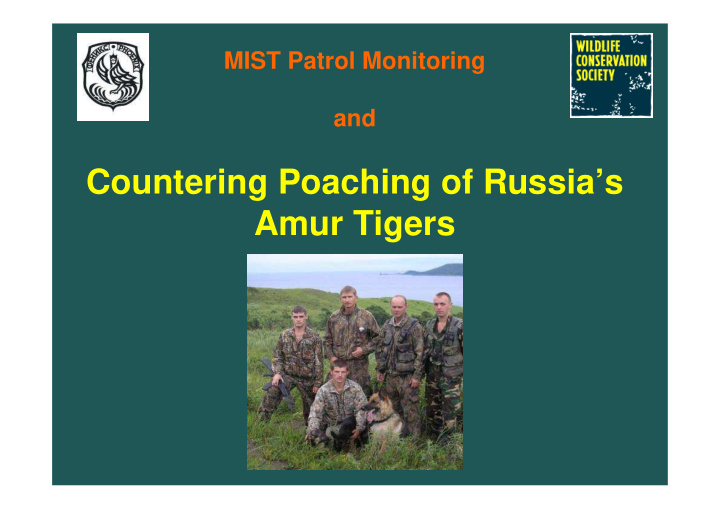



MIST Patrol Monitoring and Countering Poaching of Russia’s Amur Tigers
Objectives Increase effectiveness of anti-poaching efforts to protect tigers in 4 protected areas in Primorski Krai Increase tiger numbers both inside and outside these protected areas
PROGRAM COMPONENTS 1. Improving Protection in 4 protected areas 2. Organise Tiger and Prey Population Monitoring at these 4 sites
Project Sites in Russia � Sites 1 & 2 MIST Patrol Monitoring launched December 2010. � Sites 3 & 4 MIST Patrol Monitoring launched August 2011.
Size of the sites, present and potential tiger populations present potential area size Site tiger tiger (km2) population population Kedrovaya Pad - Leopardoviy 1805 7 27 lazovsky Nature Reserve 1220 8 18 Zov Tigra National Park 831 4 8 Sikhote Alin Nature Reserve 4014 30 40 Total 7870 49 93
PROGRAM COMPONENTS 1. Improving Protection in 4 protected areas � Introduction of the MIST patrol monitoring system � Introduction of a system of “adaptive patrol management”. � Introduction of a performance linked bonus scheme for inspectors based on quality of patrol work ($1500 per month per PA) � Provision of financial/operational support for the implementation of regular patrols ($1050) and patrol data storage ($150 per month). � Provision of ongoing technical support (helpdesk patrol data entry, data analyses, producing patrol reports, training inspectors in data collection and patrol skills)
IMPROVING PROTECTION - STEPS � Agreement with the 4 protected areas about the introduction of MIST patrol monitoring, inspector bonus system and patrol support. � Design of MIST monitoring systems for each of the 4 protected areas. � Training of inspectors in patrol data collection. Training of protected area staff in data storage. � Provision of MIST equipment (GPS units, batteries, battery chargers, a laptop computer for each protected area for data storage). � MIST monitoring test-period. � Official launch of MIST (with bonus payments and patrol support). � Start of adaptive patrol management aimed at continuously improving patrol quality (data analysis, feedback meetings, setting new patrol targets, etc). � Monitoring changes in tiger and prey population size in the protected areas.
What is MIST patrol monitoring? • A system for monitoring anti-poaching patrols developed in 1997 for protected areas in Uganda. • Based on G.I.S. technology. • Enables adaptive patrol management (patrol data collection - analysis - feedback - patrol planning). • Today, MIST is used in many countries and conservation programs, but this is the first time it is used in Russia. • MIST has been fully adapted by WCS and Phoenix for use in Russia.
MIST use in tiger sites in Asia Russia and China Burma Laos MIST Thailand Campuchea Sumatra
Advantages of MIST: • User-friendly, no need for GIS expert. • Easy to produce reports on anti-poaching efforts and results with highly visual graphs, tables and maps.
MIST data collection enables monitoring of: • Habitat • Wildlife • Threats to wildlife and habitat • Anti-poaching patrol activities • Anti-poaching results
PATROL DATA COLLECTION: MAIN FORM
PATROL DATA COLLECTION: VIOLATION FORM
PATROL DATA COLLECTION: LEOPARD AND TIGER FORM
MIST Patrol Management Process with GPS units and data forms Data entry & processing Field patrols & data collection Adaptive Management Feedback Analysis & reporting strategy meetings
Management Review & Feedback Loop • We process patrol data into 2-month patrol reports for each of the 4 protected areas. • We organise feedback meetings with the management and inspectors of protected areas. • The patrol efforts and results of each team are discussed at these meetings. • New patrol targets are set at the meetings for each team in order to continuously improve patrol quality.
Inspector Incentive Scheme ($1500 per month per protected area) • Provides financial incentive for inspectors to improve performance • Tactical mechanism to direct patrol efforts • Creates healthy competition between patrol teams (better performance) • Improves team work, team spirit & morale • May reduce staff turnover
Patrol reports – example 1
Patrol reports – example 2 Time spent on patrols (hours) November team 4 2011 team 3 team 2 team 1 0 40 80 120 160 200 240 280 пешком засада машина мотоцикл снегоход квадрацикл December team 4 2011 team 3 team 2 team 1 0 40 80 120 160 200 240 280 foot patrols road blocks vehicle motor bike snow mobile all terrain vehicle
Patrol reports – example 3
(Anti-)poaching indicators:- Anti-poaching results Results per unit effort Anti-poaching effort - uncovered violations - per patrol - no. of patrols - arrests and citations - per km patrolled - no. patrol days - per hour patrolled - patrol distance - fines and convictions - per inspector or team - confiscations - patrol start times - per $1 spent (weapons, snares, game) - no. hours patrolled - patrol coverage
PROGRAM COMPONENTS 2. Organise Tiger and Prey Population Monitoring at the 4 sites � Assess monitoring protocols at the 4 protected areas � Design and introduce modern techniques for estimating tiger and prey abundance � Conduct annual winter surveys
Thank you!
Recommend
More recommend